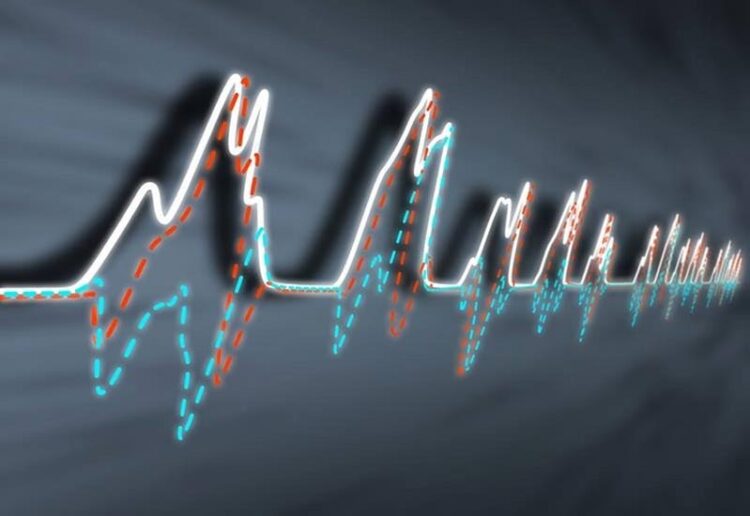Machine learning reveals hidden components of X-ray pulses

An X-ray pulse (white line) is built from ‘real’ and ‘imaginary’ components (red and blue dashes) that determine quantum effects. A neural network analyzes low resolution measurements (black shadow) to reveal the high-resolution pulse and its components.
Image courtesy of SLAC National Accelerator Laboratory
Neural networks determine the amplitude and phase of X-ray pulses, enabling new, high-resolution quantum studies.
The Science
Ultrafast pulses from X-ray lasers reveal how atoms move at timescales of a femtosecond. That’s a quadrillionth of a second. However, measuring the properties of the pulses themselves is challenging. While determining a pulse’s maximum strength, or ‘amplitude,’ is straightforward, the time at which the pulse reaches the maximum, or ‘phase,’ is often hidden. A new study trains neural networks to analyze the pulse to reveal these hidden sub-components. Physicists also call these sub-components ‘real’ and ‘imaginary.’ Starting from low-resolution measurements, the neural networks reveal finer details with each pulse, and they can analyze pulses millions of times faster than previous methods.
The Impact
The new analysis method is up to three times more accurate and millions of times faster than existing methods. Knowing the components of each X-ray pulse leads to better, crisper data. This will expand the science possible using ultrafast X-ray lasers, including fundamental research in chemistry, physics, and materials science and applications in fields such as quantum computing. For example, the additional pulse information could enable simpler and higher-resolution time-resolved experiments, reveal new areas of physics, and open the door to new investigations of quantum mechanics. The neural network approach used here could also have broad applications in X-ray and accelerator science, including learning the shape of proteins or the properties of an electron beam.
Summary
Characterizations of system dynamics are important applications for X-ray free-electron lasers (XFELs), but measuring the time-domain properties of the X-ray pulses used in those experiments is a long-standing challenge. Diagnosing the properties of each individual XFEL pulse could enable a new class of simpler and potentially higher-resolution dynamics experiments. This research by scientists from SLAC National Accelerator Laboratory and the Deutsches Elektronen-Synchrotron is a step toward that goal. The new approach trains neural networks, a form of machine learning, to combine low-resolution measurements in both the time and frequency domains and recover the properties of X-ray pulses at high resolution. The model-based ‘physics-informed’ neural-network architecture can be trained directly on unlabeled experimental data and is fast enough for real-time analysis on the new generation of megahertz XFELs. Critically, the method also recovers the phase, opening the door to coherent-control experiments with XFELs, shaping the intricate motion of electrons in molecules and condensed-matter systems.
Funding
Primary support for this research was provided by the Department of Energy (DOE) Office of Science, Basic Energy Sciences Scientific User facilities division, with secondary support from the Basic Energy Sciences Chemical Sciences, Geosciences, and Biosciences Division. The research used resources at the Linac Coherent Light Source, a DOE Office of Science user facility operated by SLAC National Accelerator Laboratory.
Media Contact
Michael Church
DOE/US Department of Energy
michael.church@science.doe.gov
Office: 2028416299
https://www.energy.gov/science/bes/articles/machine-learning-reveals-hidden-components-x-ray-pulses
All latest news from the category: Physics and Astronomy
This area deals with the fundamental laws and building blocks of nature and how they interact, the properties and the behavior of matter, and research into space and time and their structures.
innovations-report provides in-depth reports and articles on subjects such as astrophysics, laser technologies, nuclear, quantum, particle and solid-state physics, nanotechnologies, planetary research and findings (Mars, Venus) and developments related to the Hubble Telescope.
Newest articles

Parallel Paths: Understanding Malaria Resistance in Chimpanzees and Humans
The closest relatives of humans adapt genetically to habitats and infections Survival of the Fittest: Genetic Adaptations Uncovered in Chimpanzees Görlitz, 10.01.2025. Chimpanzees have genetic adaptations that help them survive…

You are What You Eat—Stanford Study Links Fiber to Anti-Cancer Gene Modulation
The Fiber Gap: A Growing Concern in American Diets Fiber is well known to be an important part of a healthy diet, yet less than 10% of Americans eat the minimum recommended…

Trust Your Gut—RNA-Protein Discovery for Better Immunity
HIRI researchers uncover control mechanisms of polysaccharide utilization in Bacteroides thetaiotaomicron. Researchers at the Helmholtz Institute for RNA-based Infection Research (HIRI) and the Julius-Maximilians-Universität (JMU) in Würzburg have identified a…



